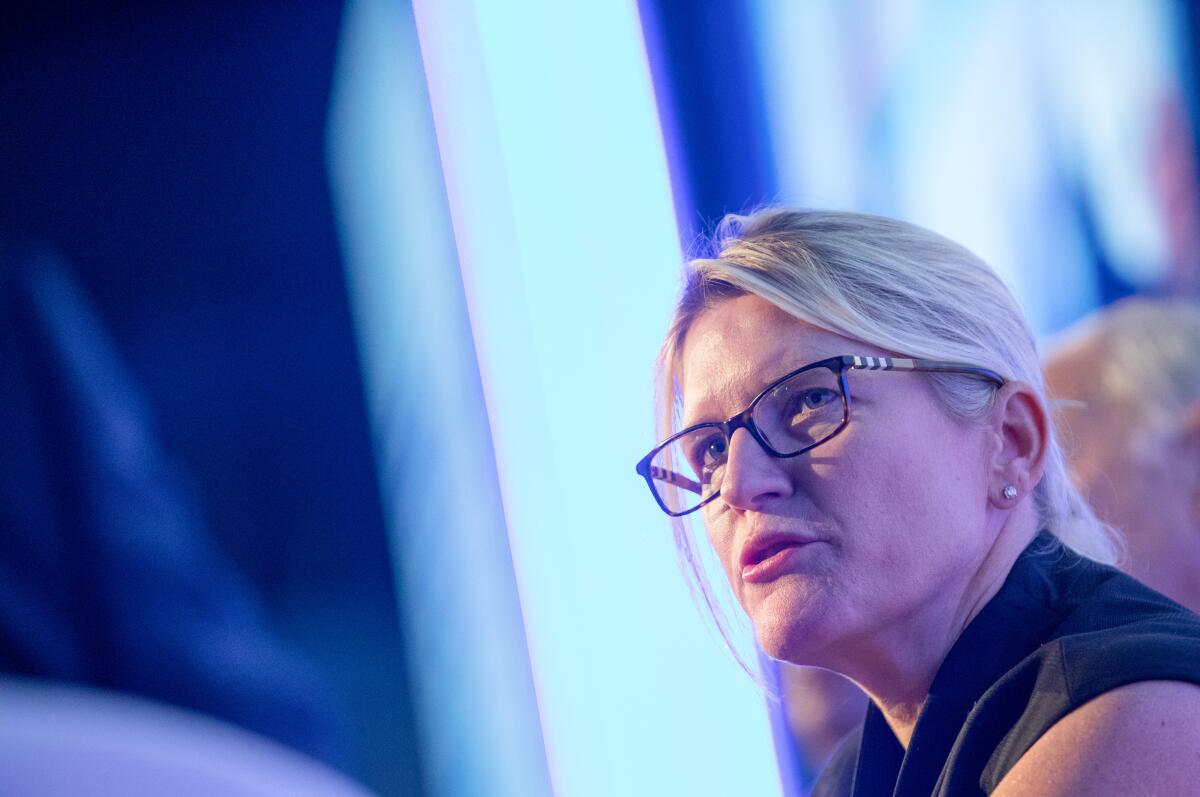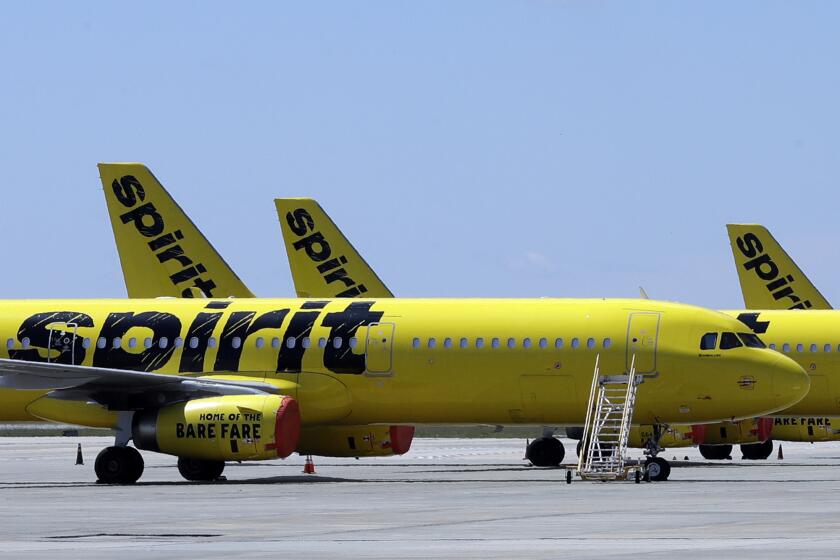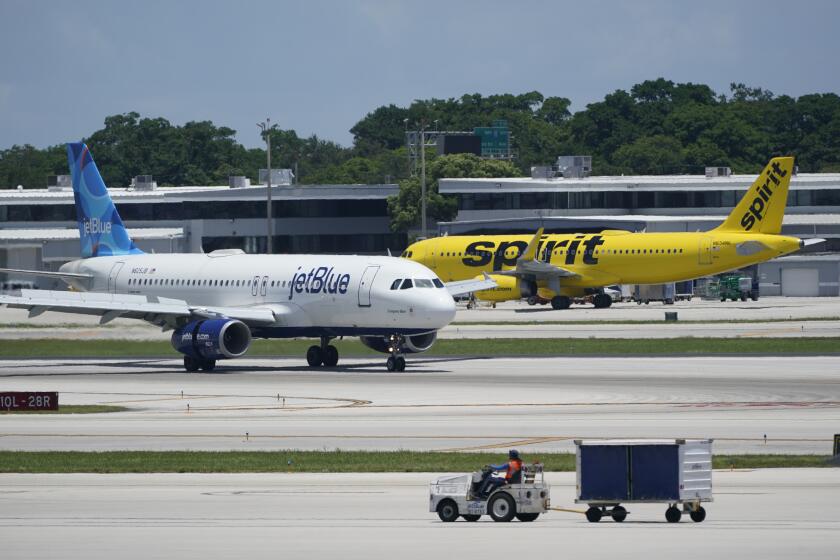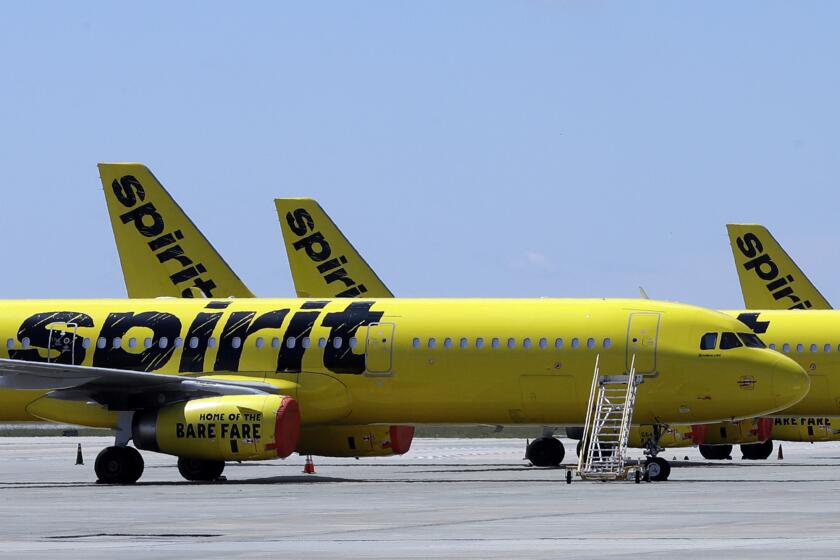JetBlue’s incoming CEO clings to Spirit deal with few other options

- Share via
Joanna Geraghty, the next chief of JetBlue Airways, spoke of having “the gift of grit” in a commencement address in 2020. She’s going to need it.
JetBlue on Friday said it would appeal a federal judge’s decision to strike down its proposed acquisition of Spirit Airlines. The decision to appeal now sets up Geraghty, who officially takes over Jetblue in February, with two seemingly impossible paths: She either prevails over the U.S. government and pushes through a merger with an already hobbled Spirit, or the deal flops and Geraghty has to formulate a whole new strategy to pump life into her own unprofitable and struggling airline.
The airline last made money in 2019, before the pandemic and a series of legal blows. In addition to a federal judge last week blocking the carrier’s plan to acquire Spirit in a $3.8-billion deal, JetBlue’s route-sharing partnership with American Airlines Group was shot down in the courts last year. Wall Street doesn’t expect the airline to so much as break even until 2025.
“Joanna’s priority has to be returning JetBlue to solid profitability and mending the balance sheet,” said Savanthi Syth, a Raymond James analyst. Additionally, the airline needs to get its fixed costs under control, she said.
The new chief executive officer, who takes the job in mid-February, is already familiar with those components of the business. Geraghty, 51, became JetBlue’s president and chief operating officer in 2018. She’s responsible for running the airline’s day-to-day operations and for its commercial performance, network, revenue management, brand and marketing.
A federal judge sides with the Biden administration and blocks JetBlue from buying Spirit Airlines, saying the deal would reduce competition.
The executive, who declined to be interviewed for this article, is described by former colleagues as diligent and assertive. Having started her career at JetBlue in 2005 as director of the litigation and regulatory department, she was long seen as a potential heir to current CEO Robin Hayes. He named Geraghty as his successor in his surprise resignation notice Jan. 8 after nearly nine years at the helm.
In public speeches, Geraghty appears at ease reciting data points and company goals relative to her role, and usually gets straight to the point. That JetBlue would appoint the now-COO, an understated nuts-and-bolts executive, to the top role is likely a sign of where the airline is these days.
Hip airline
When the carrier started flying in 2000, based out of New York’s John F. Kennedy Airport, it carved out a reputation as a hip airline that operated differently from its better-established competitors. It kept ticket prices far lower than rivals, while offering amenities designed to make air travel more fun. Passengers got live satellite TV, more leg room and a promise “humanity” would return to flying.
However, bit by bit JetBlue veered toward aviation industry norms. A severe winter storm that led to scores of flight cancellations in 2007 claimed the job of its founding CEO David Neeleman. The airline then lasered in on profitability and growth, and stopped trying to offer more free perks than its rivals.
“They used to have some pizzazz to them,” said Jason Schloetzer, an associate professor at Georgetown University’s McDonough School of Business who leads classes on evaluating companies and their performance. “But that seems to have worked off in the recent years and they seem like any other airline.”
A top Spirit Airlines executive said the company initially viewed a $3.8 billion takeover offer from JetBlue Airways as a bid to eliminate a low-cost rival.
The carrier also shifted its focus to chasing high-paying business flyers with a premium product called Mint and building transatlantic routes. In a 2019 interview with CNBC, Geraghty said JetBlue was exiting its “awkward teenage phase and becoming adults.”
Busy home base
Those costly ambitions, along with keeping its primary operating base in the busy U.S. Northeast, hit the airline’s profits. In the areas where JetBlue has flights heavily concentrated — around New York, Boston and the Southeast — there are a shortage of air traffic controllers and abundance of storms. All of those factors cause delays and extra costs, hitting JetBlue harder than competitors with more diverse operations.
Geraghty has been a vocal defendant of JetBlue’s economic interests while it’s coped with various hurdles. In conference calls about the company’s financial results, she’s pointed out failings with the U.S. air traffic control system. In October, the executive called on a new Federal Aviation Administration chief to “serve as a champion on these critical infrastructure issues.”
John Toriello, who worked with Geraghty at Holland & Knight before she left for JetBlue, said Geraghty is “very intelligent, very hard working and very confident.” She showed an early interest in the airline business even as a junior associate at the law firm, where she worked her way up to partner.
“It was quite clear to me that, unlike many other junior associates, she had vision and could see things that might be done better or improved,” he said. That strength, Toriello said, allows her to find solutions to problems and not just identify them.
JetBlue has agreed to buy Spirit Airlines in a $3.8-billion deal, a day after Spirit and Frontier Airlines agreed to abandon their merger proposal.
Geraghty also stands out by becoming the first woman to run a major U.S. airline. On average, women get less time to run major companies than men, 6.2 years versus 8.8 years, according to data compiled by Exechange.com. Though some outside observers believe JetBlue will look largely the same under Geraghty’s leadership as it did under Hayes.
“I don’t see anything in her background, despite the particular role she has, to indicate she’s going to run it any different,” said Bob Mann, head of consultancy R.W. Mann & Co. and a former airline executive.
‘Bold decisions’
In recent years, JetBlue’s executive suite has been mired in legal battles that distracted the carrier from making operational improvements. The Northeast Alliance partnership forged with American in 2020 allowed it to increase flights across the Eastern Seaboard and add new customers. When a judge ruled the partnership was anticompetitive and had to shut down, JetBlue opted not to contest the finding, saying instead it would focus on buying Spirit.
Then on Tuesday, following an exhaustive legal effort, a judge blocked the acquisition of Miramar, Fla.-based Spirit. In a one-sentence appeal filed Friday, JetBlue and Spirit didn’t give a legal reason behind the last-ditch effort to save their merger. The Raymond James analyst Syth called their chance of success “low.”
In a note to staff after her appointment as CEO, Geraghty noted that the only constant is change, and that the carrier would redouble work to run more reliable flight operations and offer a consistent product and service while maintaining competitive costs. She also said she wanted to instill a willingness to make “bold decisions.”
“This year will be a critical year for JetBlue as we take steps to get back to profitability,” she wrote. “I hope you will join me in rallying around this effort.”
More to Read
Inside the business of entertainment
The Wide Shot brings you news, analysis and insights on everything from streaming wars to production — and what it all means for the future.
You may occasionally receive promotional content from the Los Angeles Times.













